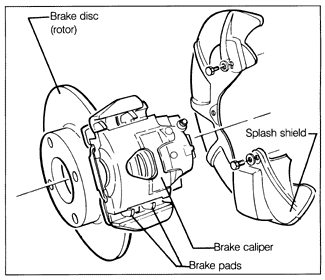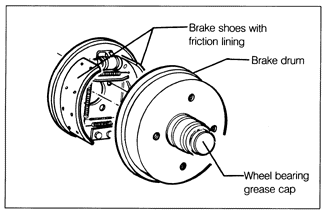1.5 BrakesThe system for slowing and stopping the car is, not surprisingly, completely independent of the systems which make it go. Although the brakes are located at the wheels where they can act most directly, and they mount to parts of the suspension system, the brakes and suspension are completely separate systems. The brakes act to slow or stop the car by causing friction. Since cars are relatively heavy, the amount of friction required to stop it safely and effectively is quite high, and requires considerable force. Virtually all modern cars use a system of hydraulics to multiply the force applied to the brake pedal and to distribute it uniformly to the four wheels. The brake pedal is connected by a mechanical linkage to the first major hydraulic component, the master cylinder, usually mounted on the firewall at the back of the engine compartment. A piston in the master cylinder creates hydraulic pressure in the brake lines going to the wheels. Because the brakes are located at the wheels and move relative to the body, the final length of brake line at each wheel is flexible, so that it follows the movement. At each wheel, the hydraulic pressure acts on the brake mechanism to cause friction and slow the wheel. The hydraulic components are sized in such a way that the driver's force applied to the brake pedal is highly multiplied by the time it acts on the wheels. Two types of brake mechanisms are in common use in modern cars. Both create braking friction by forcing a stationary friction material against a larger, rotating member attached to the wheel. A drum brake forces semi-circular shoes, lined with friction material, against the inside of a round brake drum. A disc brake squeezes pads lined with friction material against both sides of a flat, round brake disc. Both types are shown below in Fig. 1-13 and Fig. 1-14. A disc brake is generally capable of generating higher braking forces for a given size, is self-adjusting and self-cleaning, and dissipates heat more easily. Heat is a major enemy of brake efficiency which affects the friction materials ability to grip. Under extreme conditions, excess heat from repeated heavy braking can cause the brake fluid to boil, resulting in severely diminished braking capability, called brake fade. Disc brakes, because of their greater ability to dissipate heat, are more resistant to brake fade.


|